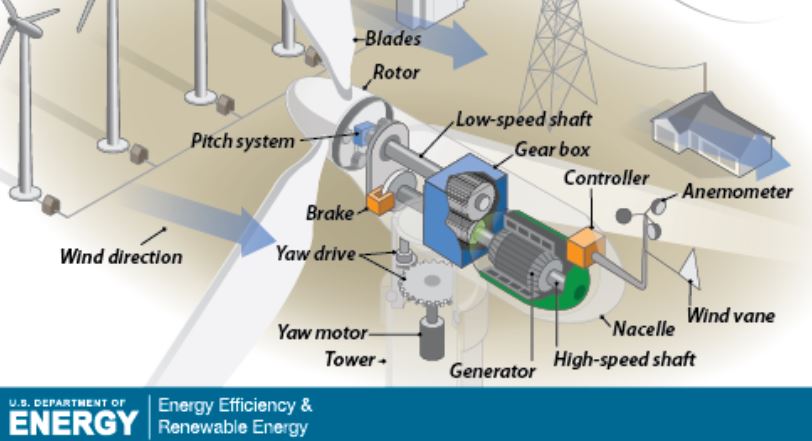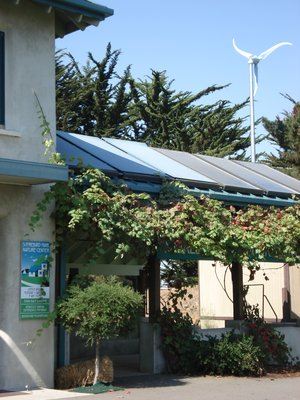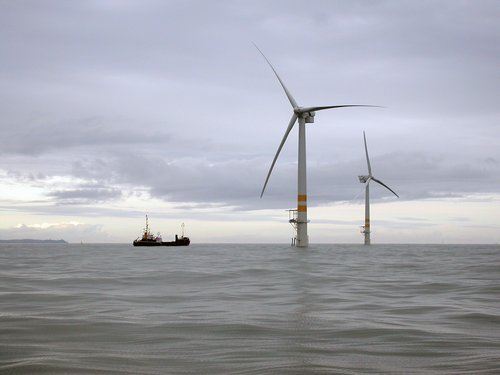To Read and View Now
- Read through the "Types of Wind Turbines" section of How a Wind Turbine Works, and click through the animation from U.S. DOE.
Now for some terminology and other considerations:
- Wind turbines convert wind to electricity. This is different than a windmill, which converts wind energy into mechanical energy that is used for another purpose (e.g., pumping water or in the "old days," grinding grain).
- A wind farm is a number of turbines that are installed in the same area, usually by the same company.
- Like solar panels, turbines have a capacity, which refers to the maximum electrical output of the turbine. A 2 MW turbine will output 2 MW of power at its peak. The amount of power is dictated by the velocity of the wind.
- Remember that energy = power x time, so if a turbine is operating at 2 MW for 1 hr, it will output (2 MW x 1 hr = ) 2 MWh of electricity. 2 MW is now considered a moderately large utility-scale turbine.
- A residential-scale turbine is much smaller, usually being a few hundred watts to a few kilowatts in size. For an example, see the image of the 2.4 kW residential turbine below. If this turbine is generating 2.4 kW for 10 hr, it would generate (2.4 kW x 10 hr = ) 24 kWh of electricity.
- Similar to solar, energy generation by a turbine is maximized by pointing the turbine so it is perpendicular to the wind. Large turbines have a mechanism that rotates the turbine so it faces the wind. This movement is called yaw.
See below for a diagram of key components of wind turbines:

Figure 7.3. Illustration of key components of a wind turbine.
Credit: U.S. Department of Energy Wind Energy Technologies Office
There is a lot to digest here. The components I'd like you to know are as follows. All quoted text is from the U.S. Department of Energy:
- Blades: "Lifts and rotates when wind is blown over them, causing the rotor to spin." The blades convert wind energy into motion energy (the rotating rotor).
- The hub (which is not indicated in the image) is the "nub" in front of the blades. Turbine heights are usually expressed using "hub height," which indicates how far above the ground the center of the hub is.
- The "blades and hub together form the rotor."
- The rotor spins the low-speed shaft, which is then (usually) converted to a higher rotation speed through a gear box.
- The high-speed shaft is attached to the other side of the gear box, which spins the generator. The generator converts this motion energy into electrical energy. Unlike solar panels, wind turbines generate AC electricity.
- The nacelle "sits atop the tower and contains the gear box, low- and high-speed shafts, generator, controller, and brake. Some nacelles are large enough for a helicopter to land on."
- The tower "supports the structure of the turbine." Modern turbines use cylindrical towers made of steel.
- Not pictured, but some modern turbines skip the gear box and use direct drive technology, spinning the generator at the same rpm as the low-speed shaft.
The basic energy conversion process is as follows:
- Solar energy is converted to wind energy.
- Wind energy is converted to motion energy by the blades, which rotates the shaft.
- The rotational velocity of the shaft is increased through the gear box. This does not increase the energy, and in fact, loses some due to frictional heat loss in the gear box.
- The gear box spins another shaft, which spins the generator.
- The generator generates an electrical current.
Turbines come in a very wide variety of sizes and capacities. The images below show some of this. (We will see the second turbine in Golden, CO!)

Figure 7.4. A typical residential-scale installation. This is a Skystream 3.7, which has a rated capacity of 2.4 kW. It has a rotor diameter of 12 feet and is mounted on a tower that is probably about 30 to 45 feet. The manufacturer’s published “energy potential” is 400 kWh/month, based on 12 mph winds.
Credit: National Renewable Energy Laboratory Photographic Information Exchange, 15337

Figure 7.5. A 100-kW Northern Power Northwind 100A turbine with 19-meter diameter blades mounted on a 30-meter tower. This installation is located at the National Wind Technology Center in Golden, Colorado.
Credit: National Renewable Energy Laboratory Photographic Information Exchange, 16392

Figure 7.6. A GE Wind 3.6-MW wind turbine, located about 10 kilometers off the coast of Arklow, Ireland. It is one of seven in the Arklow Bank Offshore Wind Power Plant. Each blade is about 165 feet long for a rotor diameter of 341 feet. Each tower weighs 160 tons and is 230 feet tall. Airtricity, a partner in the project, estimates that the 25-MW facility (7 turbines at 3.6 MW each) will generate enough electricity to power about 16,000 Irish households.
Credit: National Renewable Energy Laboratory Photographic Information Exchange, 13043